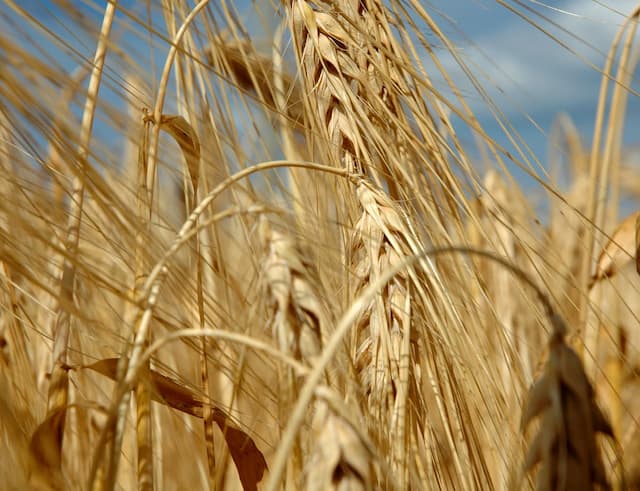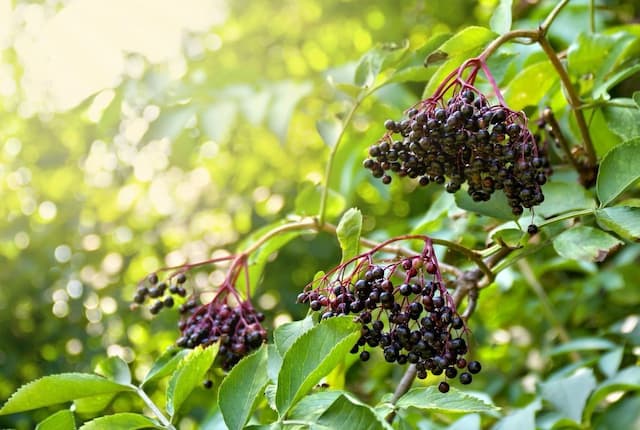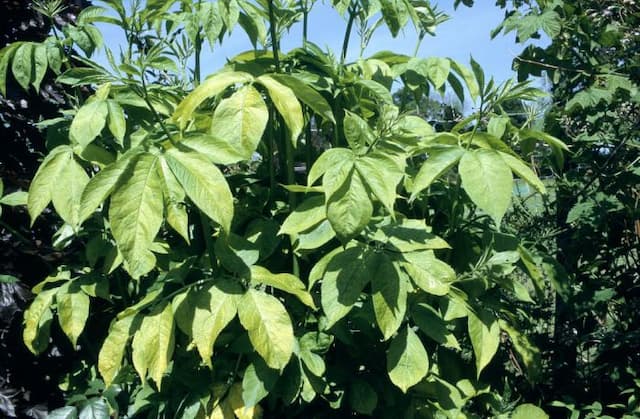Guelder Rose Viburnum opulus 'Notcutt's Variety'

ABOUT
The plant known commonly as Notcutt's Variety is a cultivar with a distinctive appearance. It showcases luxurious green leaves that have a slightly crinkled look to them, presenting a rich texture that stands out in garden settings. Throughout the blooming season, this plant is adorned with large, snowball-like clusters of flowers that can capture the attention of any passerby. The flowers typically start a lovely shade of green before transitioning to a vibrant white color as they mature. Come autumn, these striking blooms give way to shiny berries that transition through a range of hues, including red, which adds another layer of visual interest to the shrub. These colorful berries often attract wildlife, providing a feast for birds. The foliage of Notcutt’s Variety is not to be understated either; it offers a brilliant display of color change in the fall, when the leaves may turn into shades of purplish-red, giving the garden a final burst of color before the winter sets in.
About this plant
 Names
NamesFamily
Adoxaceae.
Synonyms
Guelder Rose, Water Elder, European Cranberrybush, Cramp Bark, Snowball Tree, King’s Crown.
Common names
Viburnum opulus 'Notcutt's Variety'.
 Toxicity
ToxicityTo humans
Guelder rose, including Viburnum opulus 'Notcutt's Variety', is considered to have parts that can be toxic if ingested by humans. The toxicity is mainly due to the presence of opuluside, which is a type of glycoside found in the plant. Ingesting parts of the plant, particularly the berries, can result in symptoms such as nausea, vomiting, diarrhea, dizziness, and stomach cramps. Severe poisoning can potentially cause more serious health issues such as depression of the central nervous system, and in extreme cases, seizures or coma. It is important for humans to avoid consuming any part of the guelder rose to prevent the possibility of poisoning.
 Characteristics
CharacteristicsLife cycle
Perennials
Foliage type
Deciduous
Color of leaves
Green
Flower color
White
Height
10-12 feet (3-3.7 meters)
Spread
10-15 feet (3-4.6 meters)
Plant type
Shrub
Hardiness zones
3-8
Native area
Europe
Benefits
 General Benefits
General Benefits- Ornamental Appeal: Viburnum opulus 'Notcutt's Variety', commonly known as guelder rose, features attractive flowers, berries, and fall foliage, making it a visually appealing addition to gardens and landscapes.
- Wildlife Attraction: The plant produces berries that can attract birds and other wildlife to your garden, creating a more dynamic ecosystem.
- Screening and Privacy: Guelder rose can be used as a hedge or screening plant, providing privacy for garden spaces.
- Durability: This variety of Viburnum is known for being hardy and is able to tolerate a range of soil types and environmental conditions.
- Seasonal Interest: Guelder rose offers seasonal interest with its spring flowers, summer foliage, autumn color, and winter berries, ensuring year-round appeal.
- Low Maintenance: Once established, Viburnum opulus 'Notcutt's Variety' generally requires minimal care, making it suitable for gardeners of all skill levels.
 Medical Properties
Medical Properties- Antispasmodic: May help relax muscle spasms and cramps.
- Diuretic: Can promote the production of urine, aiding in the elimination of fluids from the body.
- Sedative: May possess calming effects that could help alleviate anxiety and promote sleep.
- Astringent: Potentially tightens tissues and can reduce bleeding or secretions.
 Air-purifying Qualities
Air-purifying QualitiesThis plant is not specifically known for air purifying qualities.
 Other Uses
Other Uses- The wood of Guelder rose can be used for creating small handcrafted items such as tool handles, due to its hard and dense nature.
- Guelder rose berries, when cooked and sweetened, can be made into a jelly that pairs well with meats and cheeses, providing a sweet and tart complement.
- The flexible branches of Guelder rose can be used in basket weaving and are valuable for crafting traditional wickerwork.
- In some cultures, the dried berries of Guelder rose are strung together to make decorative garlands during the festive season.
- The ornamental value of Guelder rose, when pruned into hedges, provides a textured and colorful border for gardens with its flowers and berries.
- Guelder rose can serve as a natural dye source, with its bark yielding a black or blue dye, and its berries producing a red or pink dye for textiles and crafts.
- In the language of flowers, Guelder rose symbolizes protection due to its dense growth, and is sometimes planted as a protective charm around homes.
- Guelder rose's dense foliage can be used as a natural screen for privacy or to create a windbreak in landscapes prone to strong winds.
- When planted strategically, Guelder rose acts as a support plant for climbing vines that require a stable structure to grow upon.
- The vibrant fall color of Guelder rose's foliage provides a stunning backdrop for photography, particularly for outdoor and nature-themed photo sessions.
Interesting Facts
 Feng Shui
Feng ShuiThe Guelder rose is not used in Feng Shui practice.
 Zodiac Sign Compitability
Zodiac Sign CompitabilityThe Guelder rose is not used in astrology practice.
 Plant Symbolism
Plant Symbolism- Protection: The Viburnum opulus, commonly known as Guelder Rose, is often associated with protection due to the way its dense branches create a natural barrier.
- Unity: The Guelder Rose's round clusters of white flowers symbolize unity and togetherness, representing a community or family circle.
- Prosperity: With its abundant clusters of red berries, the Guelder Rose is sometimes seen as a symbol of prosperity and abundance.
- Bereavement: In some cultures, the vivid red of the berries represents pain and grief, thus the plant is sometimes associated with bereavement.
- Endurance: Due to its hardy nature and ability to withstand harsh conditions, the Guelder Rose can symbolize endurance and survival.
 Water
WaterThe European Cranberrybush or Guelder Rose, Viburnum opulus 'Notcutt's Variety,' prefers consistently moist soil, but it is important not to overwater. During the growing season, water this shrub deeply once a week, providing about 1 to 1.5 gallons of water each time, depending on the weather conditions. During periods of drought or extreme heat, you may need to water twice a week. In the dormant season, reduce watering frequency, checking the soil moisture level before adding water to prevent soggy soil, which can lead to root rot. The goal is to maintain a balance where the soil is moist but not waterlogged.
 Light
LightThe European Cranberrybush thrives best in full sun to partial shade. It's important to place this plant in a spot where it will receive at least four to six hours of direct sunlight a day, which encourages flowering and fruiting. However, it can also tolerate some shade, especially in hotter climates, where it may benefit from some protection during the peak afternoon sun.
 Temperature
TemperatureEuropean Cranberrybush is a hardy plant that can withstand a wide range of temperatures. It can survive minimum temperatures down to about -30 degrees Fahrenheit and is suitable for USDA hardiness zones 3 to 8. The ideal growing temperatures are between 60 to 75 degrees Fahrenheit during the growing season. Extreme heat can be stressful for the plant, so it's important to ensure adequate watering during hot spells.
 Pruning
PruningThe European Cranberrybush should be pruned to maintain its shape and health. This is best done in late winter or early spring before the onset of new growth. Prune out any dead, diseased, or crossed branches to promote better air circulation and sunlight penetration. Additionally, occasional thinning of older stems can encourage more vigorous growth and flowering. Typically, annual pruning is sufficient unless the shrub requires rejuvenation or shaping for aesthetic purposes.
 Cleaning
CleaningAs needed
 Soil
SoilThe European Cranberrybush (Viburnum opulus 'Notcutt's Variety') thrives best in well-draining, fertile soil with a pH of slightly acidic to neutral, ranging from 5.6 to 7. A suitable soil mix for this plant might include loamy garden soil, compost, and peat moss to enhance fertility and drainage.
 Repotting
RepottingEuropean Cranberrybush typically does not require frequent repotting as it is a large shrub; however, if grown in a container, it should be repotted every 3 to 5 years or when it outgrows its current pot to ensure adequate root space and soil fertility.
 Humidity & Misting
Humidity & MistingEuropean Cranberrybush prefers average outdoor humidity levels; it is quite adaptable and does not require specific humidity adjustments when planted in the garden.
 Suitable locations
Suitable locationsIndoor
Ensure bright light, cool temperature, and space for growth.
Outdoor
Plant in sun to partial shade with moist, well-drained soil.
Hardiness zone
4-8 USDA
 Life cycle
Life cycleThe life cycle of the Viburnum opulus 'Notcutt's Variety', commonly known as Guelder Rose or European cranberrybush, begins with germination, which occurs when its seeds are sown in well-draining soil and exposed to conditions that prompt growth, typically in early to mid-spring. Following germination, the seedling stage is marked by the emergence of its first leaves and roots, as it slowly establishes a foothold. Entering the juvenile phase, the plant experiences rapid growth of stems and foliage, and starts developing the characteristic lobed leaves but does not yet produce flowers. As it matures into the adult stage, the Guelder Rose begins to flower annually, typically in late spring to early summer, displaying white, sometimes pink-tinged blossoms in large, showy clusters. Following pollination, the flowers transform into bright red, berry-like drupes, attracting birds and other wildlife, which aid in seed dispersal. The plant then enters a period of dormancy during winter, where growth slows down or temporarily halts until the next spring, repeating the annual cycle of growth and reproduction.
 Propogation
PropogationPropogation time
Spring-Early Summer
The most popular method of propagating the European cranberrybush, which is the common name for Viburnum opulus 'Notcutt's Variety', is by softwood cuttings. This method typically takes place in late spring to early summer when new growth is green and flexible. To propagate, one makes a cutting 4 to 6 inches (10 to 15 centimeters) long from the end of a branch, making sure at least two sets of leaves are present. The lower leaves are removed and the cut end is dipped in rooting hormone to encourage root development. The cutting is then planted in a well-draining potting mix, covered with plastic to maintain humidity, and kept in indirect light until roots form, which usually takes a few weeks. Regular misting helps prevent the leaves from drying out before the roots have developed. Once rooted, the cuttings can be transplanted into individual pots to grow on or planted directly in their final location in the garden.




![Elder [Black Tower]](/_next/image?url=https%3A%2F%2Fplants-admin.emdemapps.com%2Fimages%2Fplants%2F%2Fimages%2F604b5cad99578.png&w=640&q=75)




